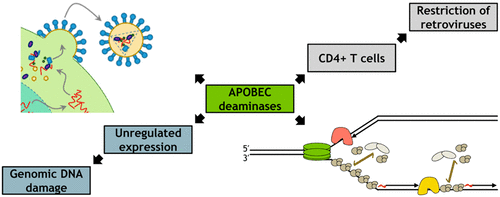当前位置:
X-MOL 学术
›
ACS Infect. Dis.
›
论文详情
Our official English website, www.x-mol.net, welcomes your
feedback! (Note: you will need to create a separate account there.)
Biochemical Basis of APOBEC3 Deoxycytidine Deaminase Activity on Diverse DNA Substrates
ACS Infectious Diseases ( IF 4.0 ) Pub Date : 2018-01-18 00:00:00 , DOI: 10.1021/acsinfecdis.7b00221 Madison B Adolph 1 , Robin P Love 1 , Linda Chelico 1
ACS Infectious Diseases ( IF 4.0 ) Pub Date : 2018-01-18 00:00:00 , DOI: 10.1021/acsinfecdis.7b00221 Madison B Adolph 1 , Robin P Love 1 , Linda Chelico 1
Affiliation

|
The Apolipoprotein B mRNA editing complex (APOBEC) family of enzymes contains single-stranded polynucleotide cytidine deaminases. These enzymes catalyze the deamination of cytidine in RNA or single-stranded DNA, which forms uracil. From this 11 member enzyme family in humans, the deamination of single-stranded DNA by the seven APOBEC3 family members is considered here. The APOBEC3 family has many roles, such as restricting endogenous and exogenous retrovirus replication and retrotransposon insertion events and reducing DNA-induced inflammation. Similar to other APOBEC family members, the APOBEC3 enzymes are a double-edged sword that can catalyze deamination of cytosine in genomic DNA, which results in potential genomic instability due to the many mutagenic fates of uracil in DNA. Here, we discuss how these enzymes find their single-stranded DNA substrate in different biological contexts such as during human immunodeficiency virus (HIV) proviral DNA synthesis, retrotransposition of the LINE-1 element, and the “off-target” genomic DNA substrate. The enzymes must be able to efficiently deaminate transiently available single-stranded DNA during reverse transcription, replication, or transcription. Specific biochemical characteristics promote deamination in each situation to increase enzyme efficiency through processivity, rapid enzyme cycling between substrates, or oligomerization state. The use of biochemical data to clarify biological functions and alignment with cellular data is discussed. Models to bridge knowledge from biochemical, structural, and single molecule experiments are presented.
中文翻译:

APOBEC3 脱氧胞苷脱氨酶对多种 DNA 底物活性的生化基础
载脂蛋白 B mRNA 编辑复合物 (APOBEC) 酶家族包含单链多核苷酸胞苷脱氨酶。这些酶催化 RNA 或单链 DNA 中胞苷的脱氨基作用,形成尿嘧啶。从人类这个 11 名成员的酶家族中,这里考虑了 7 个 APOBEC3 家族成员对单链 DNA 的脱氨基作用。 APOBEC3 家族具有多种作用,例如限制内源性和外源性逆转录病毒复制和逆转录转座子插入事件以及减少 DNA 诱导的炎症。与其他 APOBEC 家族成员类似,APOBEC3 酶是一把双刃剑,可以催化基因组 DNA 中的胞嘧啶脱氨基,由于 DNA 中尿嘧啶的许多诱变命运,这会导致潜在的基因组不稳定。在这里,我们讨论这些酶如何在不同的生物环境中找到它们的单链 DNA 底物,例如在人类免疫缺陷病毒 (HIV) 前病毒 DNA 合成过程中、LINE-1 元件的逆转录转座以及“脱靶”基因组 DNA 底物。这些酶必须能够在逆转录、复制或转录过程中有效地使瞬时可用的单链 DNA 脱氨基。特定的生化特性在每种情况下都会促进脱氨基,从而通过持续合成能力、底物之间的快速酶循环或寡聚状态来提高酶效率。讨论了使用生化数据来阐明生物功能以及与细胞数据的一致性。提出了连接生化、结构和单分子实验知识的模型。
更新日期:2018-01-18
中文翻译:

APOBEC3 脱氧胞苷脱氨酶对多种 DNA 底物活性的生化基础
载脂蛋白 B mRNA 编辑复合物 (APOBEC) 酶家族包含单链多核苷酸胞苷脱氨酶。这些酶催化 RNA 或单链 DNA 中胞苷的脱氨基作用,形成尿嘧啶。从人类这个 11 名成员的酶家族中,这里考虑了 7 个 APOBEC3 家族成员对单链 DNA 的脱氨基作用。 APOBEC3 家族具有多种作用,例如限制内源性和外源性逆转录病毒复制和逆转录转座子插入事件以及减少 DNA 诱导的炎症。与其他 APOBEC 家族成员类似,APOBEC3 酶是一把双刃剑,可以催化基因组 DNA 中的胞嘧啶脱氨基,由于 DNA 中尿嘧啶的许多诱变命运,这会导致潜在的基因组不稳定。在这里,我们讨论这些酶如何在不同的生物环境中找到它们的单链 DNA 底物,例如在人类免疫缺陷病毒 (HIV) 前病毒 DNA 合成过程中、LINE-1 元件的逆转录转座以及“脱靶”基因组 DNA 底物。这些酶必须能够在逆转录、复制或转录过程中有效地使瞬时可用的单链 DNA 脱氨基。特定的生化特性在每种情况下都会促进脱氨基,从而通过持续合成能力、底物之间的快速酶循环或寡聚状态来提高酶效率。讨论了使用生化数据来阐明生物功能以及与细胞数据的一致性。提出了连接生化、结构和单分子实验知识的模型。











































 京公网安备 11010802027423号
京公网安备 11010802027423号